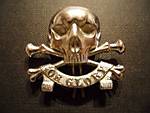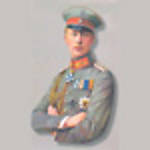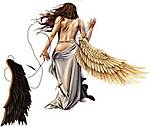AFV Painting & Weathering
Answers to questions about the right paint scheme or tips for the right effect.
Answers to questions about the right paint scheme or tips for the right effect.
Hosted by Darren Baker, Matthew Toms
Cleaning Your Airbrush

retiredyank

Joined: June 29, 2009
KitMaker: 11,610 posts
Armorama: 7,843 posts

Posted: Friday, October 22, 2010 - 09:44 PM UTC
I use both acrylics and enamels. I have even run latex through my brush. I've found that MEK is about the best way to clean enamels from your brush. MEK is dangerous stuff. Make sure you wear a mask. To get the acrylics out, I run a 5:1 distilled water and ab cleaning fluid through the brush. I usually disassemble it about once every six uses. Something most people forget, is to regularly check your siphon(about once every ten uses) for clogs. Pull the hose off, as the most common place to clog is where the hose connects to the lid. Or, just buy one siphon for acrylics and latex and another for enamels. This should stay the sludge that otherwise results from mixing enamels with water.

retiredyank

Joined: June 29, 2009
KitMaker: 11,610 posts
Armorama: 7,843 posts

Posted: Friday, October 22, 2010 - 09:48 PM UTC
Quoted Text
Wondering if anyone uses ammonia (for acrylic) or white spirit (aka mineral spirit) for enamels?
Particularly interested in knowing if white spirit will damage various seals and o-rings.
No. Don't use pure ammonia. The ammonia will etch the brass parts of your ab. I ruined my fine head by running ammonia through it, even though I generously flushed it water. Try glass cleaner or dilute the ammonia about 1:10 with distilled water.

Whitey

Joined: September 20, 2010
KitMaker: 137 posts
Armorama: 100 posts

Posted: Monday, October 25, 2010 - 01:52 PM UTC
Quoted Text
No. Don't use pure ammonia. The ammonia will etch the brass parts of your ab. I ruined my fine head by running ammonia through it, even though I generously flushed it water.
I'm glad I asked first!
Is White Spirit harmful too?
McIvan

Joined: November 18, 2009
KitMaker: 64 posts
Armorama: 12 posts

Posted: Wednesday, November 10, 2010 - 02:59 PM UTC
Quoted Text
Wondering if anyone uses ammonia (for acrylic) or white spirit (aka mineral spirit) for enamels?
Particularly interested in knowing if white spirit will damage various seals and o-rings.
I shoot a cup of ammonia based window cleaner at the end of a spray. After that (mine's a bottom feeder) I use a q-tip soaked in Tamiya thinner to clean out the orifice into whic the cup is inserted and wipe the paint out of the nozzle.
With the ammonia, the AB trigger doesn't stick anymore like it used to after I shot acrylic thinner through it for cleaning, so it is celarly doing a better job of removing paint.
Don't know anything about mineral spirits...I don't use that through the airbrush, just for washes with artists oils. If it is of any use, mineral spirits doesn't attack the acrylic paint already on the model, no matter how much I use.
McIvan

Joined: November 18, 2009
KitMaker: 64 posts
Armorama: 12 posts

Posted: Wednesday, November 10, 2010 - 03:02 PM UTC
PS: The window cleaner would be a rather low ammonia concentration. Pretty mild stuff. I wouldn't use the toilet cleaner industrial strength ammonia products if I were you. If you want to pull the AB apart and soak it for a, say, six monthly maintenance, then lacquer thinner is good...but remove the o-ring and other plastic first!
robtmelvin

Joined: October 05, 2010
KitMaker: 205 posts
Armorama: 1 posts

Posted: Wednesday, November 10, 2010 - 11:12 PM UTC
I suppose I'm either obsessive compulsive or anal retentive, take your pick, but I totally strip and clean my AB after every use. I primarily shoot enamels, but even with acrylics I still do a full strip and clean after every use. Before an injury sidelined me, I used to shoot competitively and was in the habit of totally stripping, cleaning and lubing my weapons each time I shot, competition or practice. I guess that carried over to my modeling. I just don't think you can take care of a piece of equipment too much, particularly a relatively precision type of equipment like an AB. As for WD-40, in my experience that stuff will, over time, build up a coat of gunk on your equipment that will ultimately cause you grief. I relegate it to the barn and such links as squeaky hinges.
Bob
Bob

lighthorseman

Joined: April 26, 2008
KitMaker: 84 posts
Armorama: 48 posts

Posted: Tuesday, November 16, 2010 - 08:50 AM UTC
im using the analogy that my airbrush is like a weapon and all who have served in the military will also be able to relate. every time i would live fire. the weapon would then get fully stripped and cleaned. why is this done? so you know its going to work for you when you are on a 2 way firing range. your airbrush is the same. you strip and clean it after each time you shoot paint so you know its going to work the next time you go to use it
MUNROS

Joined: September 24, 2010
KitMaker: 75 posts
Armorama: 43 posts

Posted: Sunday, November 21, 2010 - 02:18 AM UTC
Anthony, Hello. I have a paasche talon. I dump anything still left in the cup. Quick wipe with a shop towel. Run a mix of ammonia and distilled water till it comes out clear. I then remove the needle, crown cap, air cap, and tip. I soak the tip in the ammonia and water, And immediately wipe down the needle. Reassemble, and run some distilled water through. Every once in a while I'll remove the trigger, and rocker assembly to insure nothing is bleeding past the packing assembly. I've tried just running ammonia and water through. But always have a bit of paint left on the needle. I've not tried an ultrasonic cleaner, but that would seem to be the way to go. Always use acrylics.

keo

Joined: January 30, 2006
KitMaker: 613 posts
Armorama: 508 posts

Posted: Sunday, November 21, 2010 - 02:49 AM UTC
I have never heard of something called an Ultrasonic Cleaner but it sounds as a pretty good thing to supplement your day-to-day cleaning with. I like to get one; however it’ll become pretty expensive if I bought it in the US (post and taxes). Any European dealers?
ceekay

Joined: August 16, 2011
KitMaker: 2 posts
Armorama: 1 posts

Posted: Monday, August 15, 2011 - 11:58 PM UTC
(been lurking here for a while, finally registered....)
I find the best way to clean a needle-based airbrush is to clean out the jar first, fill with your choice of thinner/cleaner, then tap at the front end while holding air/material wide open until the jar is empty... The tapping diverts air backwards, so your thinner washes back and forth through the paint system. No thinner will wash back into the air line, as there is constant pressure going one way (remember to hold the brush wide-open, like you're trying to paint a real car fender with it)... No need to disassemble and scrub every time. Also works well for Mini-Jets (half-sized paint guns).
I usually spray RC bodies. I got a nice Snap-On airbrush for the task, and I've put everything through it from acrylics and enamels, to urethane-based auto paints and clear coats. Runs like a champ, only detailed it once.
Try it! It'll save you so much time that you'll have to start another kit while waiting for the first one to dry!
- CK
I find the best way to clean a needle-based airbrush is to clean out the jar first, fill with your choice of thinner/cleaner, then tap at the front end while holding air/material wide open until the jar is empty... The tapping diverts air backwards, so your thinner washes back and forth through the paint system. No thinner will wash back into the air line, as there is constant pressure going one way (remember to hold the brush wide-open, like you're trying to paint a real car fender with it)... No need to disassemble and scrub every time. Also works well for Mini-Jets (half-sized paint guns).
I usually spray RC bodies. I got a nice Snap-On airbrush for the task, and I've put everything through it from acrylics and enamels, to urethane-based auto paints and clear coats. Runs like a champ, only detailed it once.
Try it! It'll save you so much time that you'll have to start another kit while waiting for the first one to dry!

- CK

retiredyank

Joined: June 29, 2009
KitMaker: 11,610 posts
Armorama: 7,843 posts

Posted: Friday, December 09, 2011 - 08:00 AM UTC
I use a Badger 150 and I used to take it apart after every use. I have since found out that I can run a little acetone through it after every use. I haven't had to disassemble it in a month. I would not recomend this for Aztec airbrushes, as the acetone may damage the plastic nozzle. My airbrush hasn't performed so well since it was new. This works for enamels, acrylics, and laquers.
panzerbob01

Joined: March 06, 2010
KitMaker: 3,128 posts
Armorama: 2,959 posts

Posted: Friday, December 09, 2011 - 08:45 AM UTC
I echo Matt N. above...
I used to take my Iwata HP brushes down after each shoot, and resisted the idea of acetone... but tried it out only a couple months back and found it works quite well - the AB run sweet and the gunk is gone!
I would remind all that acetone - that lovely stuff which the missus casually uses to remove her nail-polish when she changes her mind about things is NOT something either to breathe nor expose - specially when a nice, thick freshly-pumped-out aerosol - to open flame
is NOT something either to breathe nor expose - specially when a nice, thick freshly-pumped-out aerosol - to open flame  ! Please use it with super ventilation and be safe!
! Please use it with super ventilation and be safe!
Cheers!
Bob
I used to take my Iwata HP brushes down after each shoot, and resisted the idea of acetone... but tried it out only a couple months back and found it works quite well - the AB run sweet and the gunk is gone!
I would remind all that acetone - that lovely stuff which the missus casually uses to remove her nail-polish when she changes her mind about things
 is NOT something either to breathe nor expose - specially when a nice, thick freshly-pumped-out aerosol - to open flame
is NOT something either to breathe nor expose - specially when a nice, thick freshly-pumped-out aerosol - to open flame  ! Please use it with super ventilation and be safe!
! Please use it with super ventilation and be safe!Cheers!
Bob

Anmoga

Joined: November 18, 2004
KitMaker: 456 posts
Armorama: 333 posts

Posted: Saturday, December 10, 2011 - 01:40 AM UTC
Hi to all,
I would like to know if it is safe to take out the needle through the front of the AB instead of from the back.
I was told once by the owner of a hobby shop in Spain that it was better to take it through the front. That was what I did until I bought my Iwata AB and when I did through the front found that it was possible but it was far more just than my old AB.
I am asking this because I don't want to damage my AB stupidly and since I want to start airbrushing after a long stop want to do it correctly.
The main advantage that I find taking the needle through the front is that there are far less risk in damaging the needle but after finding that the tolerances in the Iwata are smaller than my old brush don't want to risk damaging it.
Thanks in advance,
Angel
I would like to know if it is safe to take out the needle through the front of the AB instead of from the back.
I was told once by the owner of a hobby shop in Spain that it was better to take it through the front. That was what I did until I bought my Iwata AB and when I did through the front found that it was possible but it was far more just than my old AB.
I am asking this because I don't want to damage my AB stupidly and since I want to start airbrushing after a long stop want to do it correctly.
The main advantage that I find taking the needle through the front is that there are far less risk in damaging the needle but after finding that the tolerances in the Iwata are smaller than my old brush don't want to risk damaging it.
Thanks in advance,
Angel
Johnzie

Joined: September 15, 2012
KitMaker: 14 posts
Armorama: 14 posts

Posted: Tuesday, September 18, 2012 - 05:06 PM UTC
An airbrush is a fine instrument, with tight tolerances and several moving parts. clean your gun completely after every use and every paint change and it will never let you down. Whenever i hear of a person that cant shoot straight its usually the result of a dirty gun. Its a fine instrument......treat it as such.
John
John
dangerdan87

Joined: September 27, 2012
KitMaker: 8 posts
Armorama: 7 posts

Posted: Wednesday, October 24, 2012 - 03:17 AM UTC
You can use Ammonia to clean your airbrush, but you need to dilute the crap out of it. Windex and some some airbrush cleaners (I believe) have a small amounts of Ammonia.
I always run a good amount of water through my airbrush to clear out any cleaner.
I always run a good amount of water through my airbrush to clear out any cleaner.

1721Lancers

Joined: March 21, 2012
KitMaker: 1,673 posts
Armorama: 1,640 posts

Posted: Wednesday, October 24, 2012 - 04:32 AM UTC
Hi Anthony,
an airbrush is like a weapon, you have have to clean it when you stop firing, or you´ll get into trouble.
Paul
an airbrush is like a weapon, you have have to clean it when you stop firing, or you´ll get into trouble.
Paul
Jeroenimo

Joined: June 18, 2011
KitMaker: 9 posts
Armorama: 7 posts

Posted: Tuesday, January 22, 2013 - 11:56 PM UTC
I paint with both enamel and acrylic paints.
After I'm done spraying, I remove my cup and add a few drops of the appropriate thinning solution and spray that. After that I spray a bit of water until all paint/color is gone and only water comes out.
Then, after every painting session, I take my AB apart and use a few cutips (the earcleaning thingies) to clear most of the inside. Then it goes for a dive in the ultrasonic, usually paint still comes out then. Whole cleaning session shouldn't take more than 10 minutes but your AB will live a lot longer.
After I'm done spraying, I remove my cup and add a few drops of the appropriate thinning solution and spray that. After that I spray a bit of water until all paint/color is gone and only water comes out.
Then, after every painting session, I take my AB apart and use a few cutips (the earcleaning thingies) to clear most of the inside. Then it goes for a dive in the ultrasonic, usually paint still comes out then. Whole cleaning session shouldn't take more than 10 minutes but your AB will live a lot longer.

Blucop

Joined: January 03, 2005
KitMaker: 279 posts
Armorama: 262 posts

Posted: Saturday, February 16, 2013 - 10:36 AM UTC
Quoted Text
I paint with both enamel and acrylic paints.
After I'm done spraying, I remove my cup and add a few drops of the appropriate thinning solution and spray that. After that I spray a bit of water until all paint/color is gone and only water comes out.
Then, after every painting session, I take my AB apart and use a few cutips (the earcleaning thingies) to clear most of the inside. Then it goes for a dive in the ultrasonic, usually paint still comes out then. Whole cleaning session shouldn't take more than 10 minutes but your AB will live a lot longer.
What are you using in your ultrasonic cleaner? I have disassembled my Iwata, put it into a glass jar with lacquer thinner and then put the jar into the ultrasonic pan which contains water. Unfortunately this has given me a sticky trigger which I have yet to have figured out how to keep it from sticking after I press it down for air. I'm afraid I might have damaged something in the air valve area as even Iwata lubricant doesn't seem to help.
If cleaning in only distilled water does the job cleaning it with any type of paint, I'll try that next time.

retiredyank

Joined: June 29, 2009
KitMaker: 11,610 posts
Armorama: 7,843 posts

Posted: Saturday, February 16, 2013 - 11:30 AM UTC
Now, after much disgust with having to tear down my ab, I run a 1/3 of acetone through it. Most modern rubber o-rings are resistant to corrosives. I only take it apart after about twenty uses.
McIvan

Joined: November 18, 2009
KitMaker: 64 posts
Armorama: 12 posts

Posted: Wednesday, February 20, 2013 - 12:51 PM UTC
Quoted Text
Quoted TextI paint with both enamel and acrylic paints.
After I'm done spraying, I remove my cup and add a few drops of the appropriate thinning solution and spray that. After that I spray a bit of water until all paint/color is gone and only water comes out.
Then, after every painting session, I take my AB apart and use a few cutips (the earcleaning thingies) to clear most of the inside. Then it goes for a dive in the ultrasonic, usually paint still comes out then. Whole cleaning session shouldn't take more than 10 minutes but your AB will live a lot longer.
What are you using in your ultrasonic cleaner? I have disassembled my Iwata, put it into a glass jar with lacquer thinner and then put the jar into the ultrasonic pan which contains water. Unfortunately this has given me a sticky trigger which I have yet to have figured out how to keep it from sticking after I press it down for air. I'm afraid I might have damaged something in the air valve area as even Iwata lubricant doesn't seem to help.
If cleaning in only distilled water does the job cleaning it with any type of paint, I'll try that next time.
I had the same sticky trigger after a long soak in lacquer thinner. I'd removed the o-eing inside the brush, but I'd forgotten a rubber o-ring where the air hose attached....which is where the air-flow trigger pushes down......and the lacquer thinner had attacked it.
In time it seems to have recovered. Lesson learned...I won't forget it again.

iakarch

Joined: May 19, 2007
KitMaker: 459 posts
Armorama: 421 posts

Posted: Wednesday, February 20, 2013 - 01:12 PM UTC
I use only water based paints now and find 91% Isopropyl Alcohol works well as a cleaner but you have to be careful with it. Also dawn dishwasher soap diluted in water works better than airbrush cleaner made my media and others. As others have said a strip down cleaning is the best. A set of brushes made for the purpose makes it easy.
I read in an earlier post that someone uses MEK (methyl ethyl ketone) DO NOT USE THIS! A MASK IS NOT ENOUGH IT CAN BE ABSORBED THROUGH YOUR SKIN AND MOST GLOVES. ITS ONE OF THE MOST DANGEROUS SOLVENTS MADE. AS AN ARCHITECT I SPEAK FROM EXPERIENCE IN THE CONSTRUCTION INDUSTRY.
I read in an earlier post that someone uses MEK (methyl ethyl ketone) DO NOT USE THIS! A MASK IS NOT ENOUGH IT CAN BE ABSORBED THROUGH YOUR SKIN AND MOST GLOVES. ITS ONE OF THE MOST DANGEROUS SOLVENTS MADE. AS AN ARCHITECT I SPEAK FROM EXPERIENCE IN THE CONSTRUCTION INDUSTRY.

Snorri23

Joined: March 25, 2010
KitMaker: 514 posts
Armorama: 261 posts

Posted: Wednesday, February 20, 2013 - 01:26 PM UTC
I have several airbrushes, collect them. I personally take my needle out,paint galleries and clean the cup after each use. As for mineral spirits that is what I use to thin mm and humbrol with. Lacquer thinner is hot and I use it sparingly to do a through clean. By taking the needle through the back of the body you can damage the tip of the needle and track the residue paint through the body. Taking it through the front will eliminate these problems. By keeping things clean will eliminate ruined painting and will allow one to have endless, carefree usage.
 |










